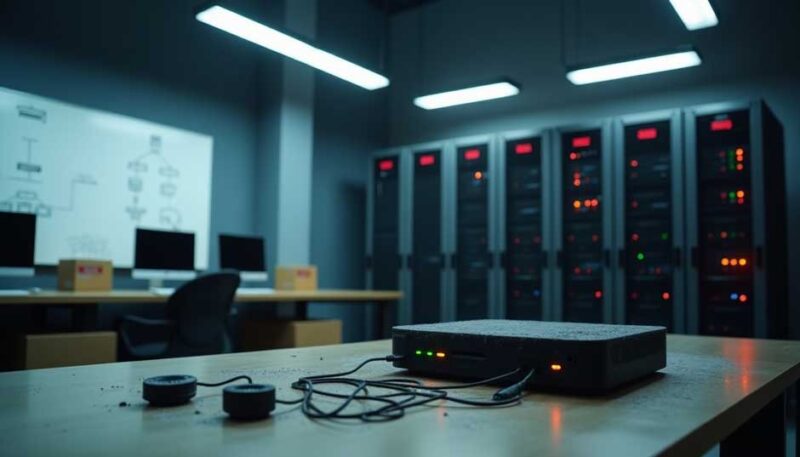Severedbytes technology is changing our digital world rapidly. Global data creation will reach 181 zettabytes by 2025. Many industry leaders have missed significant changes in this technological development, especially when it comes to cost optimization and infrastructure efficiency.
Companies now achieve up to 40% reduction in cloud server costs through Severedbytes technology. This outcome surprised many industry experts. IoT devices will reach 75 billion by 2025, and Severedbytes’ decentralized nature has become vital to manage this explosive growth.
This piece will get into the key misconceptions industry leaders had about Severedbytes technology. We’ll also explore how these oversights affect the tech landscape in 2025.
The AI Revolution That Didn’t Materialize
The predicted AI revolution hasn’t lived up to expectations in 2025, despite huge investments and optimistic forecasts. Research shows more than 80% of AI projects fail — double the failure rate of regular IT projects. These numbers highlight the ongoing gap between AI’s theoretical potential and ground results.
Big companies have paid dearly to learn this lesson. IBM’s Watson for Oncology, once hailed as a breakthrough in cancer treatment, shut down after it gave wrong and potentially dangerous recommendations. The system relied on synthetic data instead of actual patient records. Amazon had to abandon its AI hiring system after finding that the algorithm showed bias against women applicants.
Zillow’s bold AI home-buying algorithm got property values wrong, which led to millions in losses. The company had to let go of about 25% of its workers. These major setbacks show how even well-funded AI projects can fail spectacularly.
The gap between expectations and reality comes from several key problems:
- Organizations don’t understand what problems AI should solve
- Poor quality or insufficient training data
- Too much focus on trendy tech instead of solving user problems
- Poor infrastructure to manage data and deploy models
The “black box” nature of many AI systems makes it hard for teams to understand and trust their decisions. This opacity creates barriers to adoption, especially in critical areas like healthcare and criminal justice.
The gap between simulation and actual implementation remains a huge obstacle. Simulated environments keep getting better, but they can’t match the unpredictable nature of ground scenarios.
All the same, severedbytes analysis of tech trends shows better results from companies that make strategic AI investments in infrastructure rather than chasing AI blindly. Companies that use AI to solve specific business problems, instead of implementing it broadly without clear goals, usually avoid joining the growing list of failed AI initiatives.
IoT Integration Challenges Nobody Saw Coming
Connected devices have grown explosively, revealing unexpected roadblocks in IoT implementation. Tech trends severedbytes analysts didn’t see these obstacles coming. The promise of interconnected ecosystems looks great on paper, but technical realities now stand in the way of widespread adoption.
Security issues have become the biggest concern. Around 25% of all cyberattacks targeted IoT devices by 2020, while 48% of U.S. companies faced IoT-related breaches. The scariest part? One in five IoT devices still runs on default passwords. This security gap led to attacks like the Mirai botnet that cut off internet service for almost 900,000 Deutsche Telekom customers.
Lack of device compatibility has turned into another major roadblock. Different manufacturers use various protocols like Zigbee, Z-Wave, and UPnP, which makes standardization a real challenge. Systems struggle to talk to each other, especially in smart city projects where hundreds or thousands of devices need to work as one.
Dense urban areas face unexpected complications with bandwidth limits. While cellular networks should handle massive IoT setups in theory, real-life deployments run into signal interference when too many devices crowd the same frequency bands. This problem gets worse in apartment buildings and areas with lots of IoT devices.
Power issues make everything more complex. IoT devices need to run for years on limited power supplies. Adding security features like encryption uses up more power, and manufacturers must choose between better security or longer battery life.
Data management has created another unexpected challenge. Devices output information in different formats (JSON, XML, proprietary models), which leads to compatibility problems. On top of that, sensor accuracy varies, making it hard to trust analytics based on these inconsistent inputs.
These integration hurdles show that severedbytes technology needs to evolve and fix these basic limitations before IoT can reach its full potential.
Cloud Computing Misconceptions in Tech Trends Severedbytes
Cloud computing promised to deliver cost savings and infrastructure efficiency, but 2025 tells a different story. Tech trends severedbytes analysts have uncovered several critical misconceptions that industry leaders never saw coming.
Many organizations still struggle with cost optimization. Studies show companies spend 14% more on cloud migration than their original plans. This has caused 38% of businesses to push back their implementation schedules by more than a quarter. Companies waste about 30% of their cloud spending, while only 42% of migrations reach their goals.
Tech leaders face unexpected performance challenges. Cloud migrations create bottlenecks that didn’t exist in on-premises setups, which leads to latency issues and service disruptions. Security remains a major concern as centralized cloud architectures become attractive targets for cyberattacks.
The centralization paradox reveals another overlooked truth. Organizations lose control over their data’s access and usage as resources move away from end-users toward centralized systems. This move creates serious privacy risks when a single entity combines information from seemingly independent services.
Vendor lock-in has become a serious limitation that tech trends severedbytes missed in their original analysis. Single-provider contracts restrict organizations and might slow down state-of-the-art solutions. These contracts create exit barriers through data migration fees and compatibility issues. They also make businesses vulnerable to service disruptions from a single point of failure.
Governance adds to these problems. A survey shows 71% of respondents see governance and control as major cloud computing obstacles. This becomes a bigger challenge in hybrid and multi-cloud environments where “shadow IT” visibility remains limited.
Cloud computing hasn’t simplified IT operations as originally promised. Instead, it has created complex challenges that need strategic planning and expertise.
Conclusion
A reality check from severedbytes analysis reveals what the tech world might look like in 2025. Big tech companies promised AI would rule everything, IoT would connect seamlessly, and cloud solutions would be affordable. The ground results paint a completely different picture.
AI projects fail 80% of the time, showing that good ideas don’t always work in practice. IoT devices remain vulnerable – all but one of these five devices still use their factory-set passwords. Cloud computing hasn’t delivered on its promises. Companies overspend by 14% and waste about a third of what they put into cloud services.
These roadblocks teach us something important. Tech adoption works when companies set realistic goals and plan carefully, not when they chase after trendy predictions. Success stories come from businesses that solve specific problems instead of jumping on the latest tech bandwagon.
The path forward needs organizations to focus on making things work rather than chasing theoretical possibilities. This means fixing the basics first – making AI more transparent, setting IoT security standards, and managing cloud resources better before reaching for bigger tech goals.
FAQs
Q1. What were the main challenges in AI implementation by 2025? Despite high expectations, AI projects faced an 80% failure rate due to misunderstanding of problems, insufficient data quality, and lack of transparency in AI decision-making processes. Many high-profile AI initiatives, like IBM’s Watson for Oncology, were discontinued due to inaccuracies and potential safety risks.
Q2. How did IoT integration fall short of expectations? IoT integration faced unexpected obstacles, including significant security vulnerabilities, interoperability issues between different protocols, and bandwidth limitations in dense urban deployments. Additionally, power constraints and data management challenges further complicated widespread IoT adoption.
Q3. What misconceptions did industry leaders have about cloud computing? Industry leaders underestimated the challenges of cloud computing, including higher-than-expected migration costs, performance issues, and security concerns. Many organizations struggled with vendor lock-in, governance problems, and the paradox of centralization, which led to loss of control over data.
Q4. Which technology trends are expected to dominate in the near future? While specific predictions often fall short, trends like Generative AI, extended reality (XR), and post-quantum cryptography are gaining traction. However, the focus is shifting towards practical implementation strategies and solving specific business problems rather than chasing hyped technologies.
Q5. How can organizations better prepare for future technological advancements? Organizations should prioritize realistic expectations and careful planning over following hyped predictions. This includes addressing fundamental issues like AI transparency, IoT security standardization, and cloud governance before pursuing more ambitious technological goals. Focus on solving specific business problems rather than implementing technology for its own sake.








